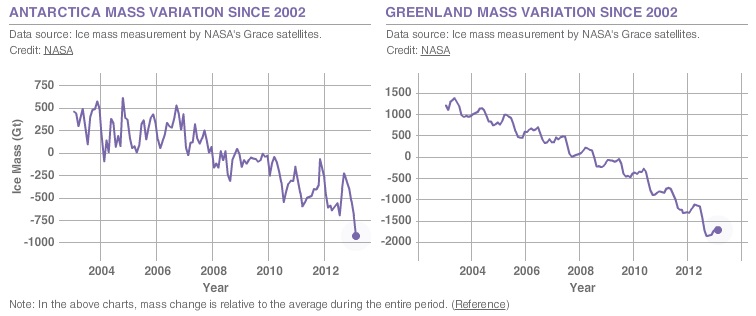Ice sheets are very vulnerable to global warming; the increase of the temperatures has enhanced glacier melting in Greenland and Antarctica. When melt-waters reach the bedrock, that the ice sheet rests upon, it, lubricates the ice sheet bottom and speeds up its movement (IPCC 2007). Regional warming in the Antarctic Peninsulatriggered ice shelf collapse, which lead to a 10 fold increase in glacier flow and rapid ice retreat (Rignot 2006). In the coming decades, significant changes in the Polar Regions will increase the contribution of ice sheets to global sea-level rise. (Bell R. 2008).

Figure 6. Data from NASA’s GRACE satellites show that the land ice sheets in both Antarctica and Greenland are losing mass. The continent of Antarctica (left chart) has been losing more than 100 cubic kilometers (24 cubic miles) of ice per year since 2002. NASA
Find out more:
- AMAP, 2012. Arctic Climate Issues 2011: Changes in Arctic Snow, Water, Ice and Permafrost. SWIPA 2011 Overview Report. AMAPs 2011 assessment of the Arctic Cryosphere (the SWIPA assessment) updates information presented in the 2004/5 Arctic Climate Impact Assessment.
- Rignot E. 2006, Changes in ice dynamics and mass balance of the Antarctic ice sheet. The Royal Society. Vol 364, No. 1844 p.1637-1655 (Abstract)
- Rignot E. 2008. Changes in West Antarctic ice stream dynamics observed with ALOS PALSAR data. J. Geophys. Res, 35 (Abstract)
- Rignot, E. et al. (2008) Recent Antarctic mass loss from radar interferometry and regional climate modelling. Nature Geosci. 1, 106–110